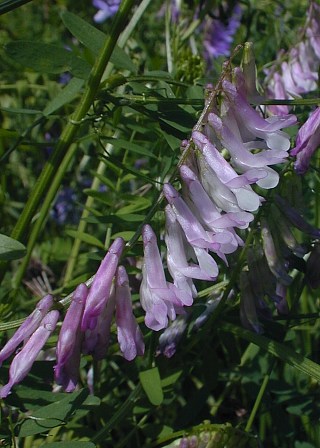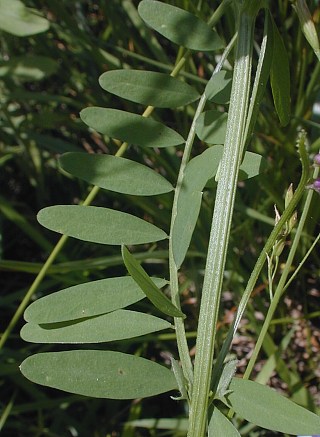Description: This plant is a winter or spring annual that becomes 1½–3' long. It has a tendency to sprawl in the absence of supportive vegetation. The stems are light green, terete, ridged, and shiny; they often have sparse fine hairs that are very short and appressed in the channels between the ridges. The alternate compound leaves are evenly pinnate with 12-20 leaflets and a pair of terminal tendrils that can cling to adjacent vegetation. Each leaflet is up to 1" long and ¼" across, light to medium green, oblong, and smooth along the margins. Older leaflets are usually hairless, while young leaflets often have a few appressed white hairs that are rather long. The central stalk (or rachis) of each compound leaf is shiny, ridged, and flat-topped; this stalk usually has short appressed hairs like the stems, otherwise it is hairless. At the base of each compound leaf (where the petiole joins the stem), there is a pair of eared stipules with narrow basal lobes. Individual racemes of flowers develop from the axils of the upper compound leaves.

About 6-20
pairs of flowers occur on one-side of each raceme; these flowers are
usually pink, otherwise they are blue-violet. Each flower is about ¾"
long, consisting of a long cylindrical corolla and a short tubular
calyx with 5 teeth. The corolla consists of 5 petals and has a typical
pea-like floral structure with a an upper standard, lower keel, and a
pair of lateral wings. The tips of the standard and wings are rounded
and spreading, while the keel is smaller and more narrow. Sometimes the
corolla is bicolored with white wings and a pink or blue-violet
standard. The shiny calyx is initially green, but later becomes the
same color as the standard (pink or blue-violet); its lower teeth are
longer than the upper teeth. The short slender pedicel of each flower
attaches to the side of the calyx, rather than at its bottom; thus, the
calyx appears to be swollen behind the pedicel. The blooming period
occurs from late spring to mid-summer; however, a few plants may bloom
later in the year. Each fertilized flower is replaced by a seedpod that
is flattened, hairy, and elongated; it contains several seeds that are
flattened and round. The root system consists of a branched taproot
that can fix nitrogen in the soil. This plant reproduces by reseeding
itself. At favorable sites, loose colonies of plants are often formed.
Cultivation:
The preference is full or partial sun, moist to mesic conditions, and
soil containing loam or clay-loam. This plant can spread aggressively.

Range & Habitat:
The non-native Smooth Vetch occurs occasionally in Illinois (see Distribution
Map). Because this species isn't distinguished from Vicia
villosa (Hairy Vetch) by some authorities, it is probably
more common than official records indicate. It was introduced into
North America from
Eurasia as a source of fodder and a
cover crop that fixes nitrogen. Habitats include black soil prairies,
disturbed grassy meadows, grassy banks of rivers, areas along railroads
and roadsides (particularly along slopes), edges of fields, and waste
areas. Disturbed areas are preferred, although it can invade prairies
and similar natural habitats.
Faunal Associations:
The nectar of the flowers attracts bumblebees, butterflies, and
skippers (especially the former). The caterpillars of some butterflies
and moths feed on the foliage of Vicia spp.
(Vetches) and other legumes, including Glaucopsyche lygdamus
(Silvery Blue), Colias eurytheme (Orange Sulfur), Caenurgina
chloropha (Vetch Looper Moth), and Cnephasia longana
(Ominivorous Leaftier). The latter species is a Tortricid moth. The
thrip Sericothrips cingulatus has been found on the
foliage of Vetches in Illinois. The seeds and foliage of Vetches are
eaten to a limited extent by upland gamebirds, including the Ruffed
Grouse, Wild Turkey, and Prairie Chicken. The foliage is palatable to
livestock and other mammalian herbivores. The seeds of some Vetches, if
they are eaten in quantity, may be poisonous to cattle.
Photographic Location:
A meadow at Judge Webber Park in Urbana, Illinois.
Comments:
Smooth Vetch is very similar in appearance to Vicia villosa
(Hairy Vetch), and some authorities consider it to be a variety of the
latter species. The stems and leaf stalks of Smooth Vetch are hairless
or sparsely hairy; in the latter case, these hairs are very short,
fine, and appressed against the stems or stalks. In contrast, Hairy
Vetch has long spreading hairs on its stems and leaf stalks. Another
difference, in my experience, is the color of their flowers: Smooth
Vetch usually has pink flowers, while Hairy Vetch usually has
blue-violet flowers. However, this distinction of floral color is not
always reliable. Another species, Vicia cracca (Cow
Vetch), has a similar appearance to the preceding species, except its
flowers are smaller (about ½" long) and the calyxes of its flowers do
not have a swollen appearance (each pedicel joins the calyx near the
bottom, rather than the side). Both Smooth Vetch and Hairy Vetch differ
from most other Vetches by their more abundant flowers (about 12-20
pairs per raceme), their eared stipules with narrow basal lobes, and
the teeth of their calyxes (the lower teeth of each calyx are longer
than the upper teeth).